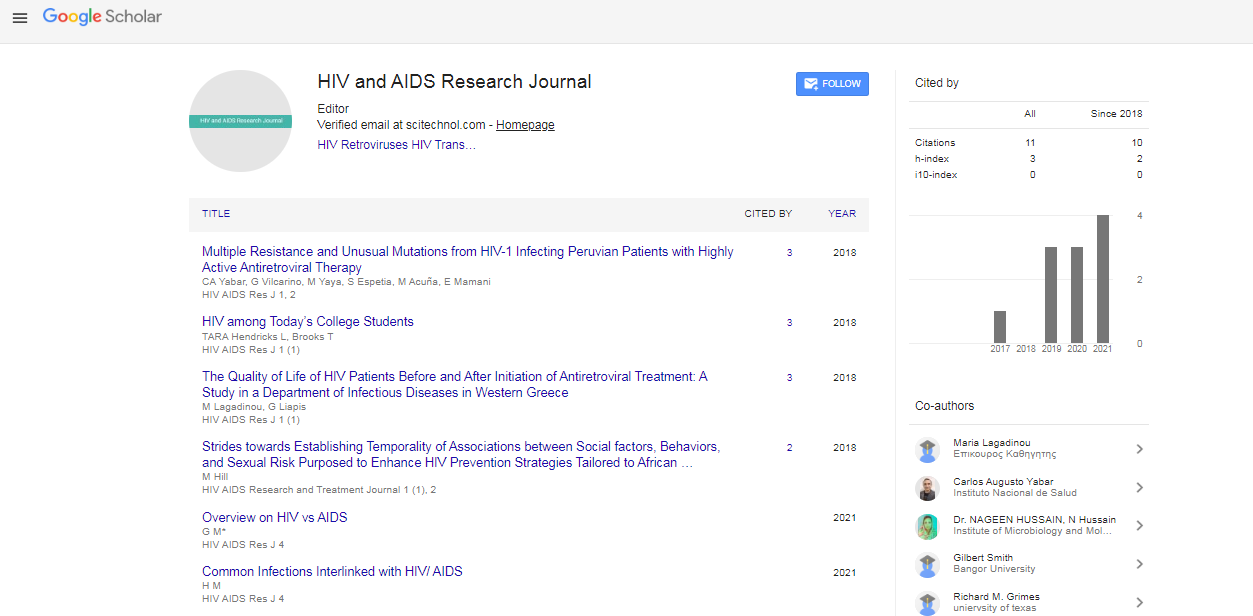Opinion Article, Hiv Aids Res J Vol: 6 Issue: 2
Systematic Analysis of Immune Responses, HIV Detection, and Treatment
Yazia Shodedh*
1Department of Infectious Diseases, University of Melbourne, Melbourne, Australia
*Corresponding Author: Yazia Shodedh,
Department of Infectious Diseases,
University of Melbourne, Melbourne, Australia
E-mail: yazia_shodedh@um11.au
Received date: 23 August, 2023, Manuscript No. HARJ-23-118051;
Editor assigned date: 25 August, 2023, PreQC No. HARJ-23-118051 (PQ);
Reviewed date: 08 September, 2023, QC No. HARJ-23-118051;
Revised date: 15 September, 2023, Manuscript No. HARJ-23-118051 (R);
Published date: 22 September, 2023, DOI: 10.4172/Harj.1000128
Citation: Shodedh Y (2023) Systematic Analysis of Immune Responses, HIV Detection, and Treatment. HIV AIDS Res J 6:2.
Description
The Human Immunodeficiency virus (HIV) has been a formidable adversary to the immune system, causing a global pandemic that has lasted for decades. Understanding how the immune system responds to HIV and the methods used for its detection is important in managing this persistent threat. The immune system is a complex and sophisticated defence mechanism that identifies and eliminates foreign invaders like bacteria, viruses, and parasites. When HIV enters the body, it targets and infects CD4+ T cells, which play a central role in coordinating immune responses. The systematic analysis of immune responses to HIV involves a series of stages.
The initial response to HIV is the innate immune system's reaction. This involves various cells, such as macrophages and dendritic cells, recognising the virus and initiating an inflammatory response. However, HIV can often evade these early immune defences. The adaptive immune system comes into play when HIV establishes a suspension. The immune system produces antibodies against the virus, and cytotoxic T cells recognise and destroy infected cells. Despite these efforts, HIV has the ability to mutate rapidly, making it challenging for the immune system to mount an effective response.
As the immune system continuously attacks HIV, it can become exhausted, and immune cells can become tolerant to the virus, which allows it to persist. HIV has evolved various mechanisms to evade the immune system, such as glycan shielding and rapid mutation. This makes it a particularly elusive target.
HIV detection techniques
Given the complexity of HIV and its ability to evade the immune system, early and accurate detection is vital for effective management and treatment. Several techniques are employed for HIV detection, each with its advantages and limitations. Enzyme-Linked Immunosorbent Assay (ELISA) and rapid antibody tests are commonly used to detect HIV-specific antibodies in the blood. These tests are reliable and cost-effective but may not yield accurate results during the early stages of infection.
Polymerase Chain Reaction (PCR) and Nucleic Acid Amplification Tests (NAATs) detect the virus's genetic material rather than antibodies. They are highly sensitive and can detect HIV earlier than antibody tests, making them valuable for early diagnosis. Western blot is used as a confirmatory test for HIV infection when the results of other tests are inconclusive. It detects specific viral proteins, providing additional diagnostic certainty.
Point-of-Care Testing (POCT) involves rapid HIV tests, often used in clinics and community settings, that provide quick results within minutes. These tests are valuable for immediate diagnosis and linkage to care. Quantitative PCR tests measure the amount of HIV RNA in the blood, providing information about the viral load and the effectiveness of treatment. Monitoring viral load is important for assessing the success of antiretroviral therapy. Monitoring CD4+ Tcell levels is essential for assessing the progression of HIV infection and the health of the immune system. While the above techniques are invaluable in diagnosing HIV, several challenges persist.
The window period, which is the time between HIV infection and when it can be reliably detected, can be several weeks to a few months. During this period, a person may have the virus but test negative. In some regions, access to advanced HIV detection techniques, like viral load testing, can be limited due to cost and infrastructure constraints.
Stigma around HIV testing remains a significant challenge. Fear of discrimination and social consequences can deter individuals from getting tested. HIV often co-occurs with other physically transmitted infections, making diagnosis and management more complex.
While there is no cure for HIV, Antiretroviral Therapy (ART) has revolutionised the management of the virus. ART involves the use of a combination of medications to suppress viral replication and preserve immune function. Starting ART as early as possible is essential to preventing disease progression and reducing the risk of transmitting the virus to others.
Conclusion
A systematic analysis of immune responses to HIV and the methods employed for its detection is essential in the ongoing fight against the virus. Understanding the complex interplay between the virus and the immune system is vital to the development of effective treatment strategies. Early and accurate detection is equally important for timely intervention and preventing the spread of the virus. As studies and technology continue to advance, the fight against HIV becomes increasingly informed and effective, bringing us closer to a world where HIV is no longer a global health crisis.
 Spanish
Spanish  Chinese
Chinese  Russian
Russian  German
German  French
French  Japanese
Japanese  Portuguese
Portuguese  Hindi
Hindi 